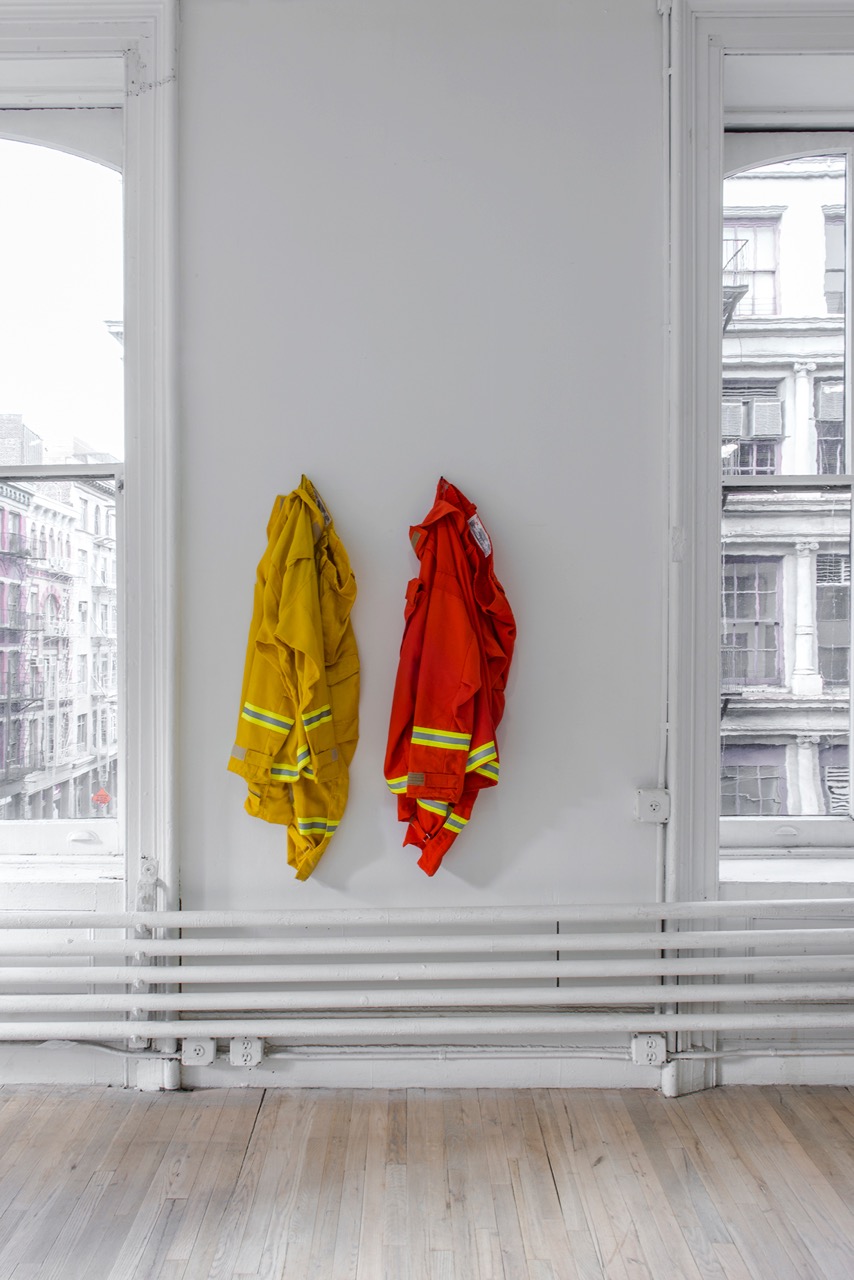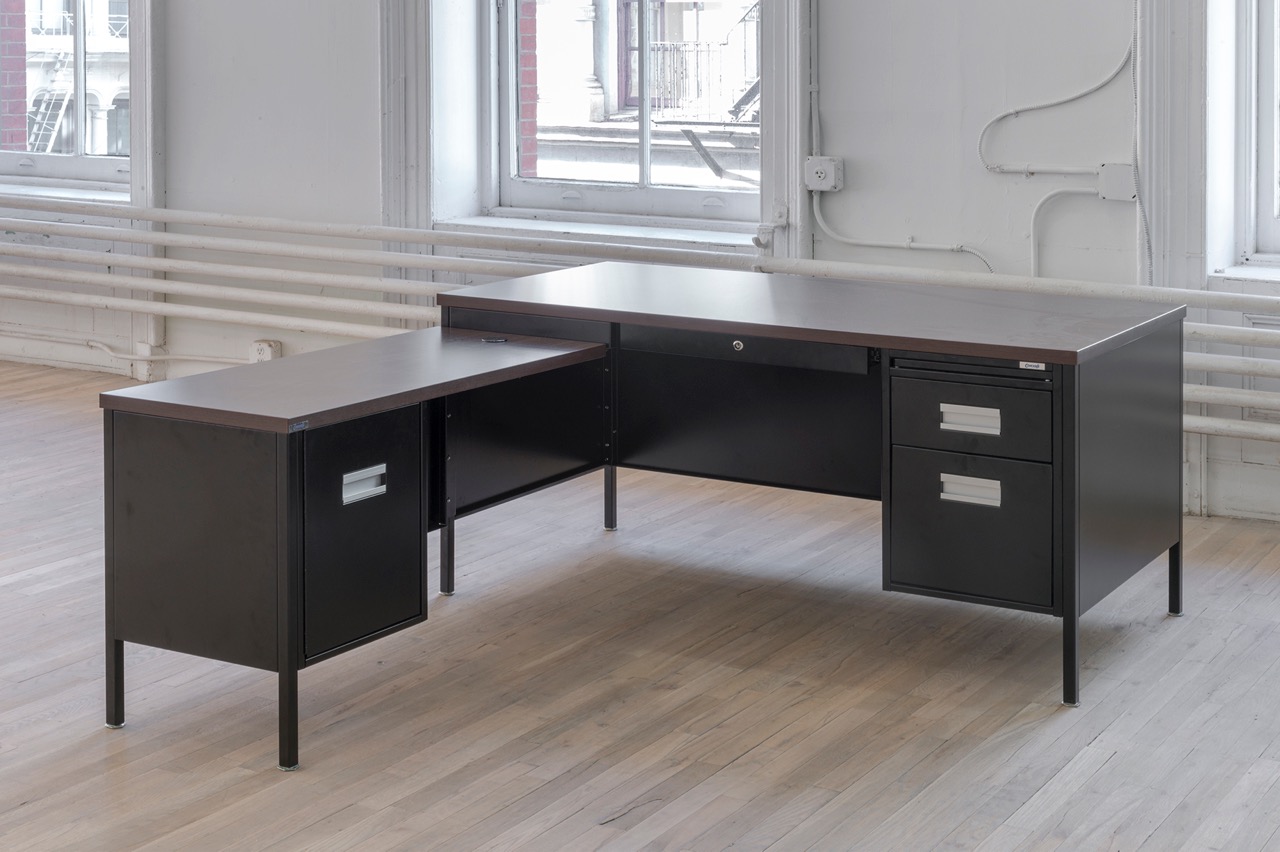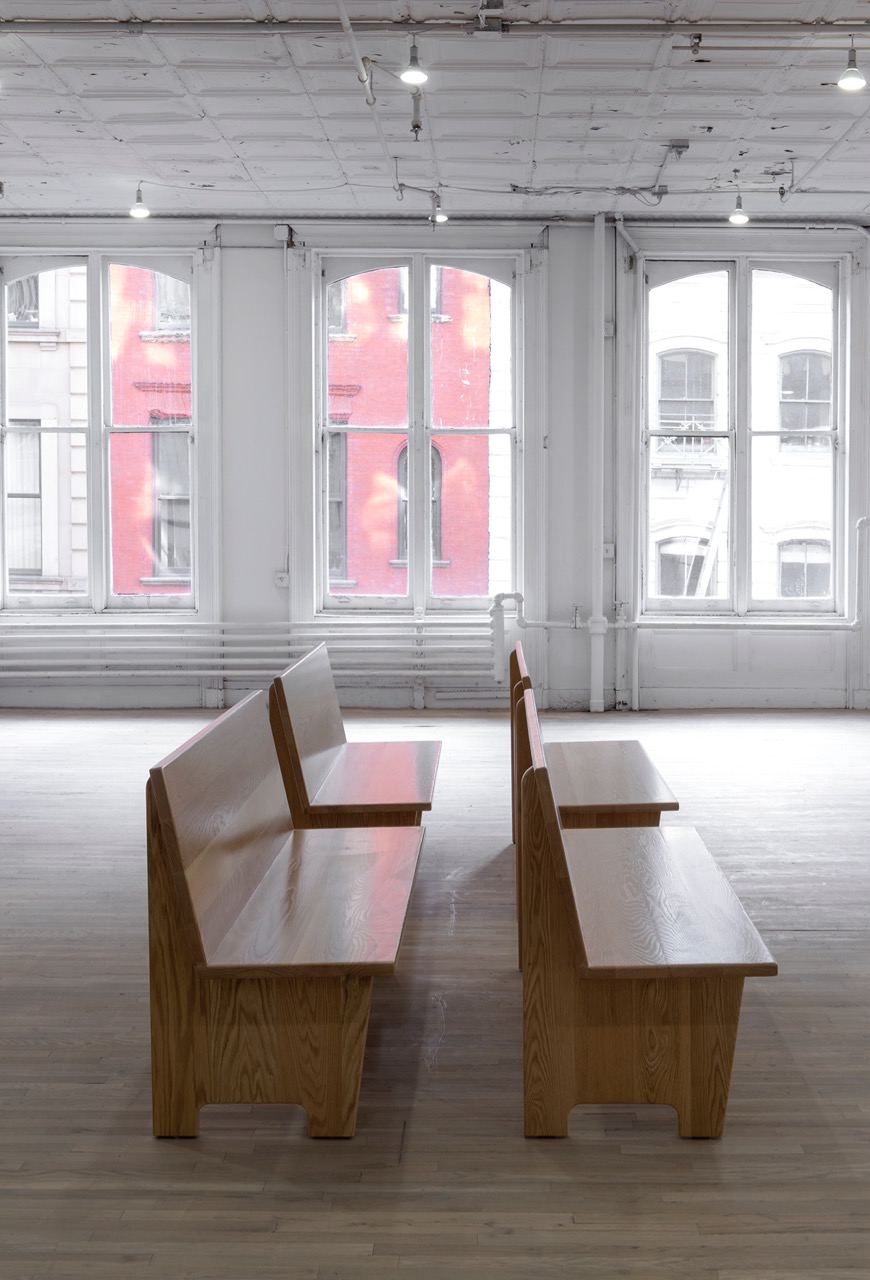
Installation view of ‘Cameron Rowland: 91020000’ at Artists Space, New York (photo by Adam Reich)
What I saw when I stepped from the elevator and entered the hush of the Artists Space gallery was barely anything: a red raincoat on the wall, some honey-colored wood benches that looked as if they belonged in a courtroom, and some odd steel contraptions on the floor. Aside from the cluster of gallery workers sitting off to the left at small desks, the room seemed so starkly bare, I asked whether I was in the right place. I was.
Handed a guide to Cameron Rowland’s 91020000, I looked at its floor schematic and then began to see what other objects make up the show. There are actually two coats as well as matching trousers, hung side by side, one bright red and one chartreuse, both Nomex fire suits titled “1st Defense NFPA 1977, 2011” (2016). There is a large L-shaped, metal office desk with dark, faux-wood laminate on top (“Attica Series Desk,” 2016) — how did I miss that? The Shaker-style benches turn out to be made of oak wood and indeed are named “New York State Unified Court System” (2016) for being typically used in this state. Towards the back, away from the door, are several large metal rings, maybe four feet in diameter, some stacked on each other, one of them lying on a wooden pallet. These are manhole leveler rings cast by prisoners in the Elmira Correctional Facility (“Leveler (Extension) Rings for Manhole Openings,” 2016). It takes me a while to understand — I get there by reading the guide’s explanation that runs about eight pages of heavily footnoted text — that this show is about quiet acts of dehumanization.

Cameron Rowland, “1st Defense NFPA 1977, 2011” (2016), Nomex fire suit, distributed by CALPIA, 50 x 13 x 8 inches. Rental at cost “The Department of Corrections shall require of every able-bodied prisoner imprisoned in any state prison as many hours of faithful labor in each day and every day during his or her term of imprisonment as shall be prescribed by the rules and regulations of the Director of Corrections.” – California Penal Code § 2700. CC35933 is the customer number assigned to the nonprofit organization California College of the Arts upon registering with the CALPIA, the market name for the California Department of Corrections and Rehabilitation, Prison Industry Authority. Inmates working for CALPIA produce orange Nomex fire suits for the state’s 4300 inmate wildland firefighters. (photo by Adam Reich, courtesy the artist and ESSEX STREET, New York)
The work makes an intellectually complex argument connecting the current forced labor of prison convicts, appropriated by the state, to America’s historical use of slave labor. Both forms of labor have generated wealth for the state, but the connection is more intimate than that. To quote Rowland: “The development of transport infrastructure and logistics was a precondition for the shipping of slaves across the Atlantic, and was the primary purpose of the slave and convict leased labor used to build U.S. railroads.”
Rowland recounts that although slaves were emancipated by the passage of the 13th constitutional amendment, immediately after its passage, laws were developed (Black Codes) that effectively criminalized black life and made these former slaves into a labor source benefiting the governments that enacted these laws. Through the practice of leasing former slaves back to former slave owners, people who were privateproperty transitioned to function, “as a kind of public property whose discounted labor benefited … governments … and corporations.” In essence, 91020000 concerns the ways and means by which, “Through an increasing set of capitalizations, people in prison have become part of a nexus of government economic interests.”
To capitalize someone or something, I discover, is to convert it into capital. In other words, Rowland contends that the prison system is premised on a practice of dehumanization similar to that which ideologically founded for the slave trade. In both cases, perversely, the labor that is stolen helps to construct and maintain a powerful economic system and its necessary infrastructure. In many states, the current economic system has become dependent on this labor and doesn’t blink when given the option of capitalizing its prisoners. That states now offer the commodities made by inmates to private nonprofit organizations, as, according to Rowland’s guide, New York began to do in 1991, entices these nonprofits (that are ostensibly initiated to carry out some public service) to be complicit in this exploitation.

Cameron Rowland, “Attica Series Desk” (2016), steel, powder coating, laminated particleboard, distributed by Corcraft, 60 x 71.5 x 28.75 inches. Rental at cost: The Attica Series Desk is manufactured by prisoners in Attica Correctional Facility. Prisoners seized control of the D-Yard in Attica from September 9th to 13th 1971. Following the inmates’ immediate demands for amnesty, the first in their list of practical proposals was to extend the enforcement of “the New York State minimum wage law to prison industries.” Inmates working in New York State prisons are currently paid $0.10 to $1.14 an hour. Inmates in Attica produce furniture for government offices throughout the state. This component of government administration depends on inmate labor. (photo by Adam Reich, courtesy the artist and ESSEX STREET, New York)
But how do we conceal the theft? The question that has to be posed when people are systematically disappeared is: Where do we hide the bodies? “In prison” is only part of the answer. The deeper, more sinister response is also the most seemingly benign: we abstract them so they become only sources of labor and wealth. We reduce them to lines in an actuarial table, an oblique reference in a statute, a number in a log book. We dissolve people into fungible assets.
The entire show mirrors this ethical catastrophe hiding in plain sight. Its title comes from the customer number assigned to Artists Space upon registering with Corcraft, the New York State Department of Corrections and Community Supervision, Division of Industries, that sells products made by inmates.
“Disgorgement” (2016) looks to use the master’s tools to dismantle the house. It consists of documents affirming the establishment of a Reparations Purpose Trust (with Artists Space as grantor and Rowland as enforcer). The trust is funded by 90 shares of Aetna insurance company purchased by Artists space, shares that will be held until “the effective date of any official action by any branch of the United States government to make financial reparations for slavery.” It’s an uncanny gesture: using a legal and financial instrument to invest in a company that once issued slave insurance policies, thus making a small part of that company invested in providing restitution to the descendants of the people it indirectly harmed — or at least causes Aetna to be a co-signer of that hope.
To be clear, this work does not argue that many or most of the people in prison do not deserve to be there. That’s not the issue. The state use of prison labor is not the samepractice as slavery, but it is an elaboration of a theme that founded this country. Several contemporary artists, including Nona Faustine, Kara Walker, Jefferson Pinder, have made work around the body, particularly the historicized, black body to remind us that the past is prologue and our bodies are always central to the story of this nation. The question of reparations, the racialized bias of the criminal justice system, policies on housing, employment, and education — they all contend with the question of how to recognize each other’s humanity and what to do once we manage that small but crucial thing.
Modernity’s practice of abstracting the body, of reducing it to property, to labor, to profit is our fundamental ethical failing. This show points to its effects on all the bodies no longer present or able to be seen. They are not even ghosts. They are poorer than ghosts, who at least can rage against the injustice of their dying and make their presence felt.

Cameron Rowland, “New York State Unified Court System” (2016), oak wood, distributed by Corcraft, 165 x 57.5 x 36 inches, rental at cost. Courtrooms throughout New York State use benches built by prisoners in Green Haven Correctional Facility. The court reproduces itself materially through the labor of those it sentences. (photo by Adam Reich, courtesy the artist and ESSEX STREET, New York)
Cameron Rowland: 91020000 continues at Artists Space (3rd Floor, 38 Greene St, Soho, Manhattan) through March 13.

No hay comentarios:
Publicar un comentario